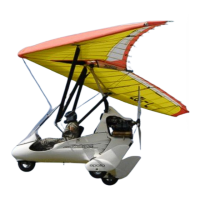Secure the nut on the bolt and assemble the safety wire hook by guiding it with one
hook before the king post and one hook behind it. Do not forget to secure it.
Roll the trike backwards until the control bar gets before the nose wheel. Lift the
wing while the vertical mast of the trike is being lifted also. Fit the nose bar into its
place and secure its bolts. Now it is advised to tie the control bar with the seat belt to
the seat frame in order to fix a small angle of attack to the aircraft while parking on
the ground. Let always the wing tip towards the wind be on the ground or turn the
trike in front of the wind and fix the control bar in a pulled in position. Against rolling
unintentionally on the ground use the parking break or use brake blocks at the
wheels.
Fill in the tank with the amount of fuel necessary for the intended flight. The aircraft
is now completely assembled, however it will only be ready to fly if the pre-flight
check has been carried out.
6.5 Flight Preparations
The Apollo WSC aircraft can be flown by its pilot if he disposes of a valid pilot licence
with the relevant type rating obtained either from an instructor entitled officially to
donate type rating for the Apollo C15 DD - Delta Jet 2 - R912 WSC type, or directly
from Apollo. If these conditions are fulfilled the entire Aerial Operation this WSC
aircraft is in the hand of its pilot. On the contrary, Ground Operation of these
aircrafts is limited. The pilot may carry out only the daily tasks in connection with the
daily aerial operation, pre-flight checks, see: 6.6 and post-flight checks, see
6.7.12 are included.
Excluded from pilot’s activity are the tasks designated by Apollo as HGO (Heavy
Ground Operation, see 5.2), such as the ones the repair of which requiring licensed
technicians If the pilot discovers a failure of this category the aircraft cannot fly until
professional repair has not been completed. The aircraft cannot fly either, when the
preceding post-flight check stated such a failure and the professional repair has not
yet been completed. It is the pilot’s obligation to document such failures discovered
and the measures done into the aircraft’s logbook.
6.6 Pre flight check point by point
Check the aircraft with surveying, touching the components surveyed; moving them
by hand if seems to be necessary, while referring to 8.3 General Safety
Prescriptions. Do the repairs, which can be managed instantly, on the spot, without
the use of any special tools. If a repair requires tools other than the ones needed to
dismantle or to fix standard joints, the repair cannot be qualified as preflight check
and after finishing with the action the check is to be repeated from the beginning. A
full pre-flight inspection should precede every flight you make, not just the first flight
of the day.

